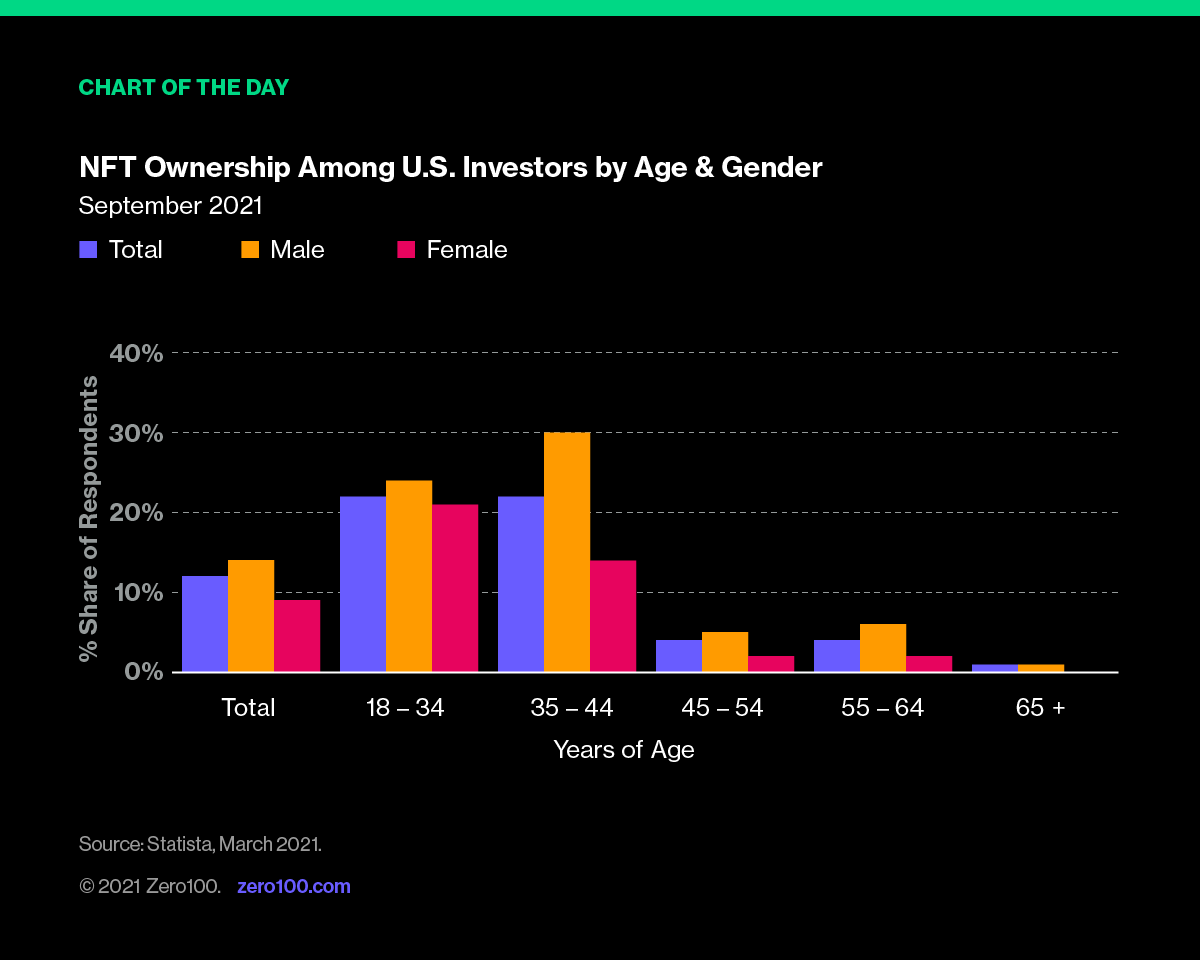Mania is a Terrible Thing to Waste
In the early 17th century, Dutch botanists competed to breed tulip bulbs that produced distinct color patterns (later determined to be the side effect of a plant virus). As the trading network grew, speculation followed—eventually producing single bulbs of Semper Augustus worth over 10,0000 guilders (enough to purchase the most expensive property in the world along the grand canals of Amsterdam). It was the first (of many) examples in modern economic history of a market bubble.
Fast forward to today and by some estimates, trading volume of NFTs (non-fungible tokens) are up at least +38,000% year-over-year (albeit off a tiny base). In March, the first NFT-based artwork (Beeple's The First 5000 Days) sold at Christie's auction house for $69 million. In November, a patch of virtual real estate located in Decentraland sold for $2.4 million, over twice the median sales price of a Manhattan apartment (already at a three-decade high). In other words, no one knows what's going on...
That Has NEVER Stopped Us Before
While only 12% of U.S. investors have reportedly invested in NFTs, the sample skews progressive young (22% of millennials). This phenomenon makes it virtually impossible for leading brands to risk non-engagement in tokens for fear of alienating customers, missing an opportunity for earned media, and/or not benefiting from any potential “halo” effect of being associated early and often with all things metaverse.

Unfortunately, the fear of missing out has led to a stampede of brand activity, often without any filtering exercise for what tangible, real-world assets a brand can port into a virtual, tokenized world. This has led to a bewildering catalog of brand initiatives documented in full here.
Our Top-5 highlights, from best examples of brand alignment to NBD include:
- NIKE: In December, Nike announced the acquisition of RTFKT Studios, a leading creator of virtual sneakers and other collectibles for sale via game engines, NFTs, blockchain, and VR/AR environments. The intersection of exclusive merchandise, celebrity collaborations, and the need to differentiate one's virtual avatar via swag is a clear win-win.
- COCA-COLA: In celebration of International Friendship Day, the iconic brand released its first set of NFTs in conjunction with a virtual rooftop party hosted in Decentraland. Proceeds from an accompanying online auction for loot boxes went to benefit the Special Olympics, bridging the brand's offline and online activities.
- WARNER BROTHERS: To commemorate the arrival of The Matrix: Resurrections sequel in December, the publisher's consumer products division partnered with Nifty to sell 100,000 NFT avatars who would then be offered a red pill / blue pill choice to change their appearance on the film's release date. Meta.
- AB InBev: In November, Budweiser issued NFTs for its new “Heritage Collection” comprised of 1,936 digital beer cans that sold out within an hour, netting just shy of $1 million. This is a natural extension of the brand's upper-end merchandising business selling limited edition neon bar signs, baseball hats, bomber jackets, and needlepoint Clydesdale coaster sets. Don't judge...
- STATE FARM: In the run-up to the Packers-Chiefs game on November 7th, State Farm hosted an augmented reality scavenger hunt (think Pokémon Go) to find 500,000 virtual footballs, which could be redeemed via mobile app for prizes including limited edition NFTs. This is a conventional marketing campaign with a digital twist.
The Myth: Digital = Carbon Friendly
Beyond ensuring alignment with the interests of young consumers and enabling the alchemic art of transmuting value out of nothing, there is another strong brand pull from NFTs. Namely, such instruments represent an early example of an exclusively digital supply chain—where nothing is produced other than 0's and 1's. However, it is wrong to assume that just because the “product” described above is created, sold, or exchanged virtually, it is not without real-world impact.
An impact assessment of an early Nifty auction featuring the work of Joanie Lemercier found that the 10-second sale consumed 8.7 megawatt-hours of energy. That was the equivalent of powering the artist's studio for approximately two years.
In response, auction houses have attempted to find ways to guarantee carbon offsets from significant sales, but the current calculation is heavily weighted towards the creation of the underlying asset versus the surrounding activity of its extended virtual lifecycle from promotion to transfer to indefinite storage and usage.
To put things in a wider perspective, the global banking industry consumes approximately 264 Terawatt-hours of energy per year. Mining and trading bitcoin consumes a bit less than half of that sum, but it is largely additive (and closing the gap fast).
Make no mistake—the world of crypto, blockchain, and NFTs is computing-intensive, and therefor energy-intensive by extension. It is NOT zero carbon by any measure.
Critical Reading
THE VERGE
Nike just bought a virtual shoe company that makes NFTs and sneakers ‘for the metaverse'
Commentary: Arguably the best example of accretive value in the red-hot NFT space, doubling down on the footwear giant's core offline strengths: collaborations, exclusivity, and personalization.
#NFT #metaverse
CNN STYLE
Digital dress code: What will we wear in the metaverse
Commentary: Excellent deep dive into the industry that will be at the forefront of experimentation in the metaverse, featuring case studies on Gucci, Louis Vuitton, Nike, Ralph Lauren, Grant, and more.
#metaverse #fashion
VENTURE BEAT
Sweep, which helps companies capture carbon emissions data in their supply chain, raises $22M
Commentary: Example of a new API that helps address the “scope 3” problem that handicaps more than 90% of organizations in their attempt to quantify their total carbon emissions—an obstacle that is reinforced by the dialog around the net impact of NFTs.
#smartstartup #carbonaccounting
